Only 1% of the global population of Southern Giant Petrels Macronectes giganteus breeds around the coastline of continental Antarctica. In this region there are here only four known breeding localities, the largest being the Frazier Islands, a group of three islands located in East Antarctica at 66° 13’S, 110° 11’E, approximately 16 km offshore from the Australian Casey Station.
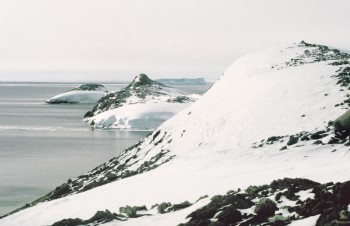
The three Frazier Islands with Nelly Island in the foreground, Dewart Island in the middle and Charlton Island iat the back
The three islands (Nelly, Dewart and Charlton) lie in the eastern part of Vincennes Bay in Wilkes Land. Nelly Island is the largest (c. 0.35 km²). There are no higher plant species with vegetation on the islands limited to a few species of lichens, algae and snow algae. The topography of the Frazier Islands is characterised by steep cliffs rising from the sea. On Nelly Island there is a high peak of about 65 m. There are broad valleys on both Nelly and Dewart Islands that are covered by large areas of snow even during summer.
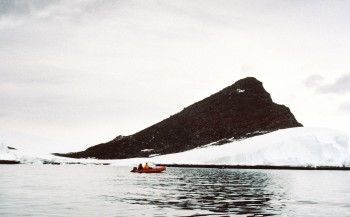
Nelly Island, with its highest peak in view. Visits are now only made by small boat
Southern Giant Petrel colonies are found on all three islands, both on the cliffs and in the valleys. In the valleys the giant petrels use the flat areas around the colonies as a runway to take off. The first giant petrel colony on the Frazier Islands was discovered on Nelly Island in 1955.
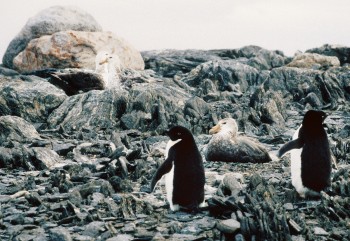
Adélie Penguins visit a Southern Giant Petrel colony
By Antarctic standards the Frazier Islands support a varied avian breeding community. Five fulmarine petrel species breed: in addition to Southern Giant Petrels, there are Snow Petrels Pagodroma nivea, Pintado or Cape Petrels Daption capense, Antarctic Petrels Thalassoica antarctica and Antarctic or Southern Fulmars Fulmarus glacialoides. Wilson’s Storm Petrel Oceanites oceanicus, South Polar Skua Catharacta maccormicki and Adélie Penguin Pygoscelis adeliae also breed.
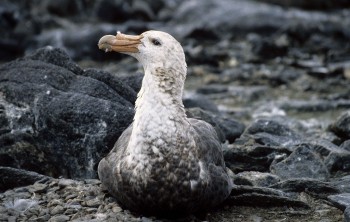
An adult Southern Giant Petrel at the Frazier Islands
The population of Southern Giant Petrels at the Frazier Islands has fluctuated, but there is no significant trend. The most recent estimate of the population was of 248 breeding pairs in 2001/02. Breeding colonies of Southern Giant Petrels are found on all three of the Frazier Islands.
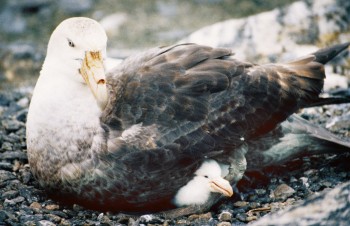 A Southern Giant Petrel broods its small chick
A Southern Giant Petrel broods its small chick
The three islands have been designated as an Antarctic Specially Protected Area (ASPA No. 160) with a terrestrial area of roughly 0.6 km². Conservations efforts (as set out in the ASPA’s Management Plan) were taken in the mid-1980s to minimise human disturbance. Since then, there have been no efforts to band chicks or adults on the islands and aircraft operations are prohibited, with transport to the islands being restricted to small boats.
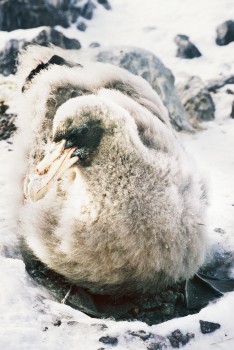
A large Southern Giant Petrel chick n March
Due to limited access to the Frazier Islands, specific details on the petrel’s local breeding biology are scarce. There are no observations from early in the breeding season, but most birds probably have commenced breeding by the end of October. In November, adults with eggs have been recorded. Around the end of December most of the eggs have hatched. Half-way through March only a few adults are present in the colonies and virtually all the chicks will be alone on their nests. The first chicks probably fledge in April.
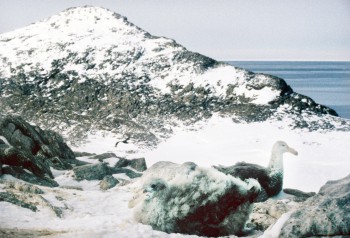
A post-guard chick and adult on Dewart Island, with Nelly Island behind
All photographs by Jeroen Creuwels
Chicks and adults have been irregularly banded on the Frazier Islands from 1961 up to 1985. Fledglings disperse throughout the Southern Hemisphere, and birds banded as chicks have been recovered in New Zealand, South America, Easter Island, and South Africa within nine months of departure. The recovery of a frozen corpse of an incubating adult on Dewart Island that was originally banded as a chick at Ile des Pétrels, Pointe-Géologie (ASPA 120) in East Antarctica shows movements between colonies can occur.
Breeding site accounts are available for two of the three other Southern Giant Petrel breeding localities in East Antarctica: Giganteus Island and Hawker Island.
Selected References:
Creuwels, J.C.S., Stark, J.S., Petz, W. & van Franeker, J.A. 2004. Southern Giant Petrels starve to death while on the Antarctic Continent. Marine Ornithology 32: 111-114.
Creuwels, J.C.S., Stark, J.S., Woehler, E.C & van Franeker, J.A. & Ribic, C.A. 2005. Monitoring of a Southern Giant Petrel Macronectes giganteus population on the Frazier Islands, Wilkes Land, Antarctica. Polar Biology 30: 483-493.
Department of Sustainability, Environment, Water, Population and Communities 2011. National Recovery Plan for Threatened Albatrosses and Giant Petrels 2011-2016. Hobart: Australian Antarctic Division, Commonwealth Department of Sustainability, Environment, Water, Population and Communities. 30 pp.
Patterson, D.L., Woehler, E.J., Croxall, J.P., Cooper, J., Poncet, S. & Fraser, W.R. 2008. Breeding distribution and population status of the Northern Giant Petrel Macronectes halli and the Southern Giant Petrel M. giganteus. Marine Ornithology 36: 115-124.
van den Hoff, J. 2011. Recoveries of juvenile Giant Petrels in regions of ocean productivity: potential implications for population change. Ecosphere 2(7): art75. doi:10.1890/ES11-00083.1.
Wienecke, B., Leaper, R., Hay, I. & van den Hoff, J. 2009. Retrofitting historical data in population studies: southern giant petrels in the Australian Antarctic Territory. Endangered Species Research 8: 157-164.
Woehler, E.J. & Johnstone, G.W. 1991. Status and conservation of seabirds of the Australian Antarctic Territory. In: Croxall, J.P. (Ed.). Seabird Status and Conservation: a Supplement. International Council for Bird Preservation Technical Publication No. 11. pp. 279-308.
Woehler, E.J., Riddle, M.J. & Ribic, C.A. 2003. Long-term population trends in southern giant petrels in East Antarctica. In: Huiskes, A.H.L., Gieskes, W.W.C., Rozema, J., Schorno, R.M.L., van der Vies, S.M. & Wolff, W.J. (Eds). Antarctic Biology in a Global Context. Leiden: Backhuys Publishers. pp. 290-295.
Jeroen Creuwels, Naturalis Biodiversity Center, Leiden, The Netherlands & John Cooper, ACAP Information Officer, 09 July 2013

 English
English  Français
Français  Español
Español